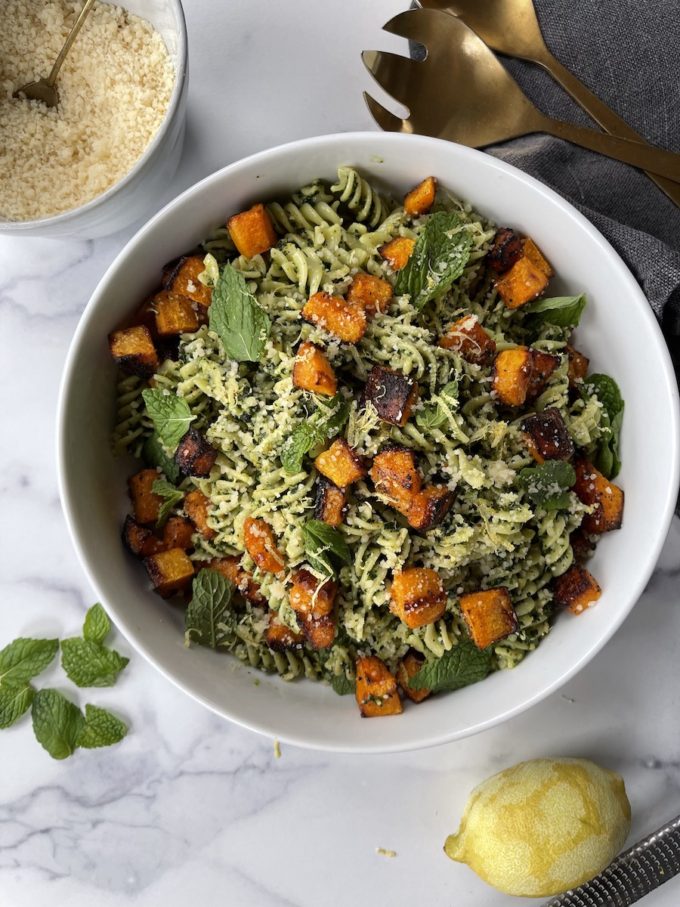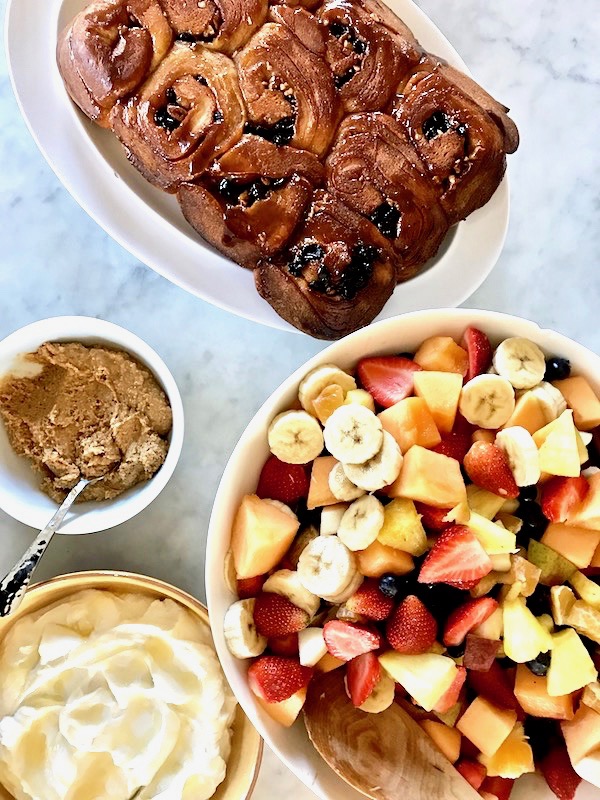Are carbs healthy? What foods have them? How can I eat carbs in a way that makes me feel good?

If there is one common denominator between nearly every new client I work with, it is a fear of carbohydrates. Most people are trying their best to minimize this macronutrient in their diet, either by cutting it out entirely, limiting it to specific meals, or downplaying it to the greatest extent possible throughout the day. When they do eat carbs, they express guilt explicitly or implicitly.
This is understandable given our cultural narrative which has demonized carbs for the last two decades. This narrative has been fuels by countless diets like Atkins, Paleo, and Keto.
So, what’s the deal? Should we be concerned about carbohydrates? When measured alongside its buddies, fat and protein, is it the least essential macronutrient?
Let me answer right up front that my response is an emphatic NO. All three macronutrients – carbohydrates, fat and protein – are equally essential. When we prioritize one (or two) over the others, our nutrition begins to get…funky.
Let’s talk about what makes carbs so great, other than the fact that they are f-ing delicious.
- First and foremost, carbs are our bodies’ preferred energy source and our brains’ sole energy source. Carbohydrates are digested into blood sugar aka blood glucose which provides this energy. Energy is pretty darn important if we want to enjoy our lives. We need it to move around but also to breathe, digest and think. Can our bodies make energy from protein and fat if they must? Yes, because our bodies are incredible and really like living. Do they want to do this? No. They’ll let us know they aren’t psyched by making us feel tired and spacy. And they most certainly will make us daydream about carbs leading to intense cravings. (Btw, if you find yourself feeling bingey on carb-rich foods at night, that may be a sign that you need to eat more food in general and/or more carb-rich foods during the day.)
- Carbohydrates are also satisfying. Many of them are high in fiber which takes a beat to break down, keeping us satisfied for longer.
- Fiber from carbohydrates also aids in digestion. Translation: Fiber helps gently rake our intestines, cleaning them out and adding bulk to our poop.
- Our intestines are also home to millions of helpful bacteria that feed on fiber from carbs. There is a growing body of research that shows just how critical a role this helpful bacteria plays in our overall health. We gotta feed those helpful critters the good stuff.
By now I hope you are on board that carbohydrates are magnificent and deserve to be a part of nearly every meal and snack. Next up, let’s get into what foods contain carbs and how you might choose them depending on how you want to feel.![]()
What foods contain carbohydrates?
- Fruits
- Vegetables
- Grains
- Legumes (aka beans and nuts)
- Dairy (this one surprises people sometimes but lactose is a carb)
- And every food derived from the above (e.g., juice, sugar derived from the sugar cane plant and all other caloric sweeteners, potato chips, breakfast cereals, snack foods like crackers and cookies, breads from white to whole wheat, pastas, etc.)

Are certain carbohydrates “better” than others?
Let me put the most important part up front: All carbs – refined or not, laced with sugar or not – can be a part of a healthy diet. It is the big picture of what we eat that matters and a healthy diet leaves plenty of room for fun foods that don’t center nutrition.
Knowing the details about how carbs hit our bloodstream and turn into blood sugar can be helpful in understanding how our carb choices make us feel. Ultimately, the more fiber (or in the case of dairy, protein and fat) that is packaged along with carbohydrate, the longer the carbohydrate will take to break down into blood sugar. The less refined a carbohydrate, typically the more fiber. The longer something takes to break down, the longer we stay satisfied before feeling hungry again.
Higher fiber carbs
- Whole fruits
- Whole vegetables
- Whole grains and whole grain products
- Legumes
- (Dairy does not contain fiber but it does have protein and fat that slow down digestion/absorption similar to fiber)
Lower fiber carbs
- Foods derived from the above
- Fruit and vegetable juice
- Fruit and vegetable purees, especially when pulp has been removed
- Chips, pretzels, crackers, etc.
- Breakfast cereals
- Baked goods like white bread, muffins, pancakes, etc.
- Pasta
- Sweets
Sometimes we want to feel full for a long time and sometimes we don’t. Say it’s lunchtime and you want your meal to keep your satisfied for 4-6 hours and provide you with lots of long energy. You might choose:
A sandwich on 100% whole grain bread (high fiber carb), loaded with veggies (more fiber), a slice of cheese (satisfying fat) and turkey (protein) + an apple (high fiber carb) +/- chips (low fiber carb)
This meal has high fiber carbs + protein + fat meaning you will be full of energy for hours.
If you are about to hit the gym and need fast energy that is easy to digest, choosing a lower fiber carb source is preferable. This might look like:
An English muffin (low fiber carb) with a tiny swipe of butter (fat that’s just for flavor here) and jam (low fiber carb) + an apple sauce pouch (low fiber carb)
This meal has mostly low fiber carbs. You will get a hit of easy to digest energy that you can use at the gym to maximize your movement. You’ll need to refuel shortly after you leave.
So no carb is better than another carb, it’s just depends what you want to get out of them. But no matter what, a healthy diet entails that one eat carbs.
A note about insulin.
As mentioned up front, blood sugar from carbohydrates fuels the activity of all of our bodies’ cells, especially our brain cells. But it can’t get into cells without some help. Insulin, a hormone made by the pancreas, acts as a key to open up cell doors and let blood sugar in. Because our bodies don’t like a ton of sugar hanging out in our blood stream, a surge in blood sugar from foods like low fiber carbohydrates leads the pancreas to release a corresponding surge in insulin. All of the sugar is quickly ushered out of our blood stream and into cells.
This is great when we’re exercising and we need that quick energy. Once we’re done, we can refuel and be ready to go on with our day.
When we’re not exercising and we eat lower fiber carbs completely on their own as a meal or snack, we might feel tired and/or hungry within a couple of hours of eating. This is because the easily digested lower fiber carbs resulted in a surge of blood sugar, corresponding surge in insulin and precipitous fall in blood sugar. It doesn’t feel great. Our bodies like there to be a little blood sugar traffic in the blood stream so that they have easy to access energy in case they need it. So, low blood sugar triggers hunger hormones so we’ll eat and get those levels back up.
Alternatively, when we eat mixed meals with carbs, protein and fat like the turkey sandwich option mentioned above, the meal takes longer to break down. Our blood sugar rises slowly and steadily overtime. Correspondingly, our pancreas releases insulin slowly and overtime. There is a steady flow of light blood sugar traffic in our blood stream. When insulin moves some blood sugar into our cells, a little more blood sugar merges onto the highway from our GI tract to replace it. This translates to our blood sugar rising and falling slowly and overtime. Our bodies have plenty of energy and feel satisfied for longer. This feels good. We can be all-in in life without any background food thoughts.

A helpful way to think about carbs.
All carbohydrates are good. From a nutrition perspective,
- Those carbohydrates that are higher fiber (or protein and fat in the case of dairy) are great for long lasting energy and to prolong fullness/satisfaction, particularly when they are paired with protein and fat from other foods.
- Those carbohydrates that are lower fiber are great for quick, easy to digest energy when you are about to exercise and don’t want to ask too much of your GI tract.
- Pairing any carbohydrate (low or high fiber) with protein and/or fat will slow down digestion and absorption. If you want to feel satisfied for longer with plenty of energy, aim for a combo of macronutrients.
- Plan to eat carbs with every meal and snack A meal/snack without carbs here and there is fine. Remember it’s the BIG PICTURE of what you eat.
- Use you hunger/fullness to gauge how much carb your body needs in light of the fact that you’ll also be including protein and fat most of the time. Ideally, a balanced snack may hold you 2-3 hours and a balanced meal may hold you 3-6 hours. If either doesn’t hold you that long, consider whether you ate enough and/or whether you had a good balance of the macronutrients: carbohydrate, protein and fat.
- Independent of energy and satisfaction, a diet that includes plenty of high fiber carbohydrates is great for your GI tract health. Choose them when you can to help you poop and keep your gut bacteria flourishing.
- A healthy diet leaves plenty of room for foods that are meant simply for pleasure, including low-fiber, refined carbohydrates like sweets, chips, soda, etc. Enjoy them without guilt. The more you make peace with these fun foods and allow them to be a part of your daily eating, the easier it is to enjoy them in a way that feels good. More on that concept another day!
So, what do you think? Are you back on Team Carb? What questions do you still have? Leave me a comment below or reach out if you need help making peace with carbs.